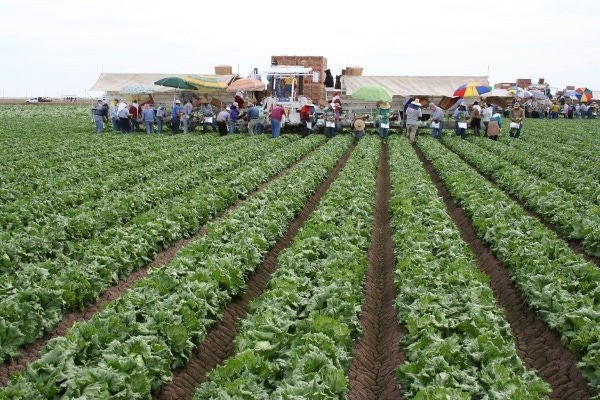
Arizona Veg IPM Update: leafminer management and Fusarium wilt disease in lettuce
As temperatures cool down in the next week or so, it is important to remember Liriomyza leafminers, particularly as the first produce fields approach harvest.Leafminer numbers have been light to moderate so far this season. Higher numbers - adults and larvae – have been observed on older lettuce leaves at the Yuma Agricultural Center.Fusarium wilt disease on lettuce in Arizona is found annually from mid-October through early January.The initial disease symptom is the yellowing of one or more older leaves followed by leaf wilting and death.
October 24, 2012

The latest Arizona Vegetable Integrated Pest Management Update (Part 1) from the University of Arizona (UA) Cooperative Extension in Yuma, Ariz. released Oct. 18, 2012.
Leafminer management on fall lettuce
By John Palumbo, UA Research Scientist and Extension Specialist
The weather remains warm and we are not out of danger from most fall insect pests. As temperatures cool down in the next week or so, it is important to remember Liriomyza leafminers, particularly as the first produce fields approach harvest.
Leafminer numbers have been light to moderate so far this season. We have recently observed higher numbers (adults and larvae) showing up on older lettuce leaves at the Yuma Agricultural Center in Yuma.
Much like last season, an increase in adult flies has been observed on yellow-sticky traps used for monitoring whiteflies over the past week or so. In most cases, these traps were located near or adjacent to fall melons, cotton, or alfalfa.
With temperature forecasts in the 80’s and 90’s for the next week, leafminer adults should continue to be active. Larval activity could easily cause damage if left uncontrolled in lettuce or baby leaf fields where currently present.
These larvae can cause significant damage to older, pre-harvest lettuce by feeding and damaging wrapper leaves of head lettuce and romaine. Pupae collecting within the leaf margins can also be considered contaminants.
In addition, baby leaf lettuces, spring mixes, and spinach are susceptible to larval feeding (mining) on the tender-growing leaves.
These populations can be effectively controlled with current products. Products for armyworm, looper, and thrips control include Radiant (5-7 ounces/acre), Coragen (5-7 ounces/acre) and Voliam Xpress (9 ounces/acre).
These products can effectively kill newly emerged larvae in the leaf mines before significant damage occurs.
Similarly, Agri-Mek at the 8-12 ounce/acre rate can provide long residual control.
Be sure to include a penetrating adjuvant with these products to enhance product translaminar movement and larval control.
For more information on leafminer biology and management, click on this link: "Leafminer Management."
Click this link to listen to John's update.
“Remember, when in doubt - scout.”
Contact Palumbo: (928) 782-3836 or [email protected].
Fusarium wilt on lettuce
By Mike Matheron, UA Extension Plant Pathologist
Since the first detection of Fusarium wilt on lettuce in Arizona occurred during the 2001-02 growing season, the disease has been found annually in lettuce fields from mid-October through early January.
This year is no exception with the first confirmed appearance of Fusarium wilt on lettuce recorded this week.
The initial visual suggestion of the disease is the yellowing of one or more older leaves followed by leaf wilting and death.
The external root surface is unaffected. A brown-to-black necrosis of the internal taproot and crown tissue will be apparent.
Disease incidence can range from a few plants up to large areas or zones of infected plants within a field.
Plants can become infected and display symptoms at any age’ ranging from very young plants just after thinning to those ready for harvest. The Fusarium wilt symptoms resemble the lettuce disorders’ ammonia toxicity and early stages of lettuce drop.
To confirm disease identity, bring plant samples to me at the Yuma Agricultural Center for analysis. Confirmation of disease identity is achieved by isolation and identification of the causal fungus of Fusarium wilt of lettuce, Fusarium oxysporum, f. sp. lactucae, from symptomatic root tissue.
Disease development is strongly affected by planting date and type of lettuce grown.
The main determinant of disease severity with respect to planting date is soil temperature. Research data demonstrate that lettuce planted in early September can result in high levels of Fusarium wilt. Plantings in the same naturally-infested field started in mid-October or early December sustain moderately low and trace levels of disease, respectively.
Of the many crisp head and romaine cultivars tested, crisp head cultivars generally are significantly more susceptible to Fusarium wilt than romaine lettuce.
The lettuce Fusarium wilt pathogen can survive in soil for many years. Minimizing the spread of infested soil within and especially between fields is of paramount importance.
Two comprehensive research reports concerning disease development and management of Fusarium wilt of lettuce are available. Please contact me and I will email these reports to you.
Click this link to listen to Mike's Update.
Contact Matheron: (928) 726-6856 or [email protected].
You May Also Like



